Toast and grind whole spices and crush dried herbs. Blend together to create a peppery, slightly spicy, not too salty Montreal steak seasoning recipe.
Flavor steak, burgers, chicken, potatoes, and more. This is an easy seasoning mix to make and store. Plus, it is a unique gift to give to your favorite chef.
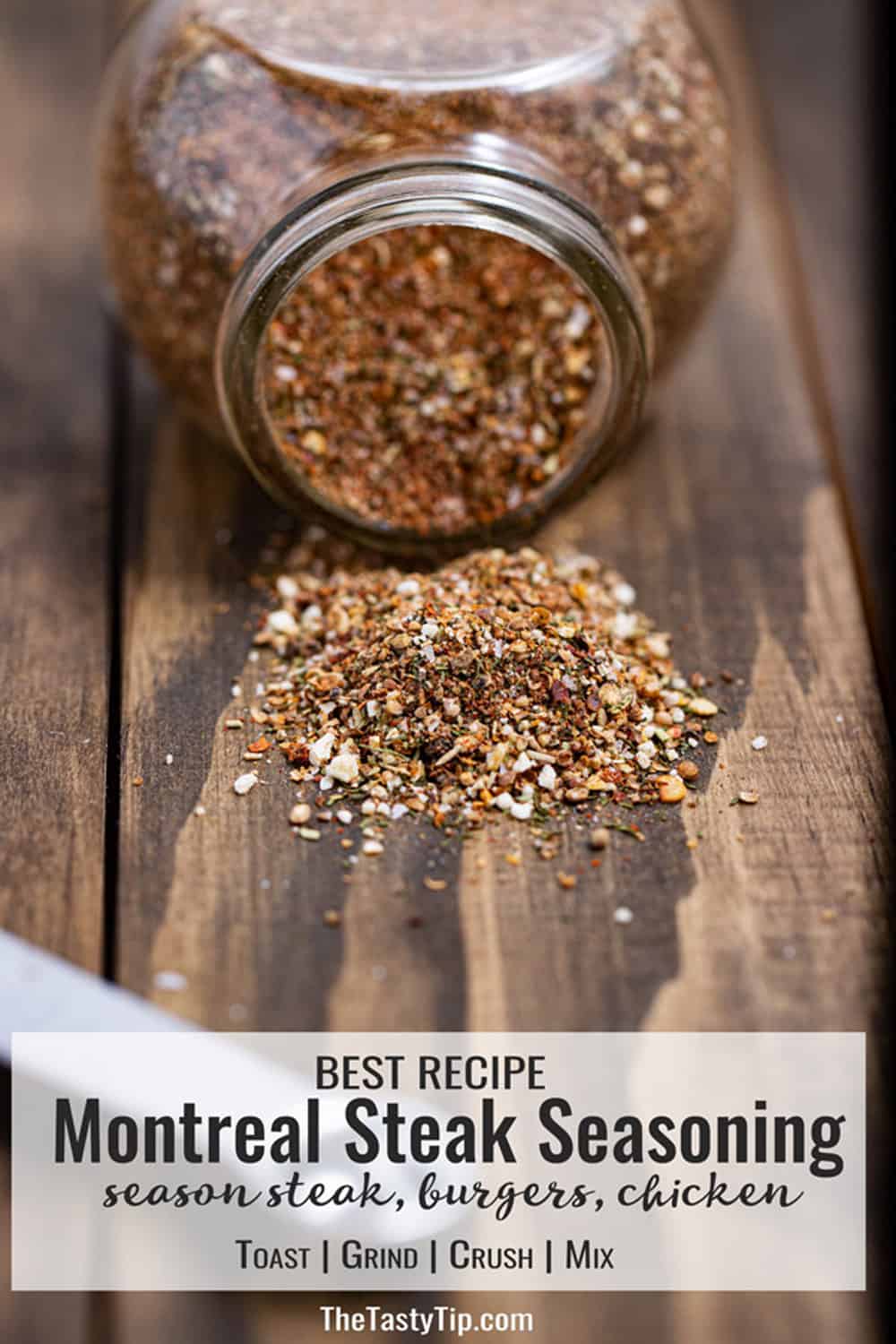
Nine years ago, at a toddler’s birthday party, I bit into a burger my friend had grilled. And I paused.
I have never been much of a hamburger fan. But this was no ordinary burger. It was delicious — peppery, piquant, complex, interesting. The hostess was a culinary school graduate. So, I figured she used some technique to make the meat taste amazing.
When I asked her about it, she simply said, “Montreal steak seasoning.”
That was my first introduction to a seasoning that has been around for more than 70 years.
Who Invented Montreal Steak Spice?
Over 70 years ago, Morris Sherman, a skinny man nicknamed “The Shadow,” created a sensation by accident.
Sherman worked as a grill man at Schwartz’s, a smoked meat deli in Montreal, Canada. Reuben Schwartz owned the restaurant.
Schwartz allowed his employees to eat liver steak for free. Sherman “The Shadow” wanted to make his meat more flavorful, so he seasoned it with a concoction of spices.
As the legend goes, Sherman unassumingly added Schwartz’s Jewish pickling spices to the liver steaks as he grilled them.
Since he was grilling right in front of the customers, people noticed what he was doing. They requested the same seasoning on their food too. And with that, the Montreal steak seasoning recipe was born.
The seasoning became so popular in the community that Schwartz’s deli began selling the seasoning mix to its customers.
Soon other Montreal delis and steakhouses began duplicating the recipe for their customers.
At first, Montreal steak seasoning was only sold locally. But that changed when the flavor experts from McCormick Canada visited Montreal in the late 1980s.
They fell in love with the seasoning and decided to bottle and sell it. Initially, they intended to sell the spice blend to restaurants only.
But even after distributing samples to chefs in restaurants, no orders came.
However, McCormick’s did receive repeated requests for the samples from restaurant employees. As it turned out, employees took the seasoning mix home and cooked with it.
It was so popular with home chefs, McCormick’s decided to launch the seasoning in supermarkets. Instead of selling the spice blend to restaurants.
It was a massive success, becoming McCormick’s top-selling spice. Montreal steak seasoning become an international sensation thanks to McCormick’s.
This is What's Wrong with Commercial Montreal Steak Seasoning
You may have seen it on grocery store shelves. Many brands of Montreal steak seasoning. Small hand-crafted versions, as well as mass-produced spice blends, vie for shelf space.
After my introduction to the seasoning, I began stocking it in my pantry and using the perfect blend on many meat dishes. However, over time, I couldn’t keep overlooking a significant problem. It was far too salty.
In my experience, all the commercially produced Montreal steak seasonings are too salty. And I like salt. But McCormick’s Montreal steak seasoning recipe adds too much salt. And McCormick’s was the brand I used the most.
I also suspected it was so salty to hide the taste of old bland spices.
My easy Montreal steak seasoning recipe eliminated the problem of tasteless spices and too much salt.
Why You Will Love Making Your Own Montreal Steak Seasoning Recipe
- Control the salt level. You will love homemade spice mixes if you have to watch your salt intake. Add the amount of salt you are comfortable with.
- Use the freshest spices and herbs. A flavorful seasoning needs a bright and fresh blend of spices.
- Toast the spices to enhance their flavor. The best part of homemade Montreal steak seasoning is blooming the spices. When you make your own spice blends, always toast the whole spices.
Heat the spices in a pan over medium heat until they are fragrant. Cool them. Then grind, and you will have the best steak seasoning flavor you have ever experienced.
- Customize the recipe. Your homemade version doesn’t have to be a copycat recipe. Add more dill seed. Skip the salt. Replace red chili pepper flakes with cayenne pepper. The possibilities are endless.
What’s in Montreal Steak Seasoning?
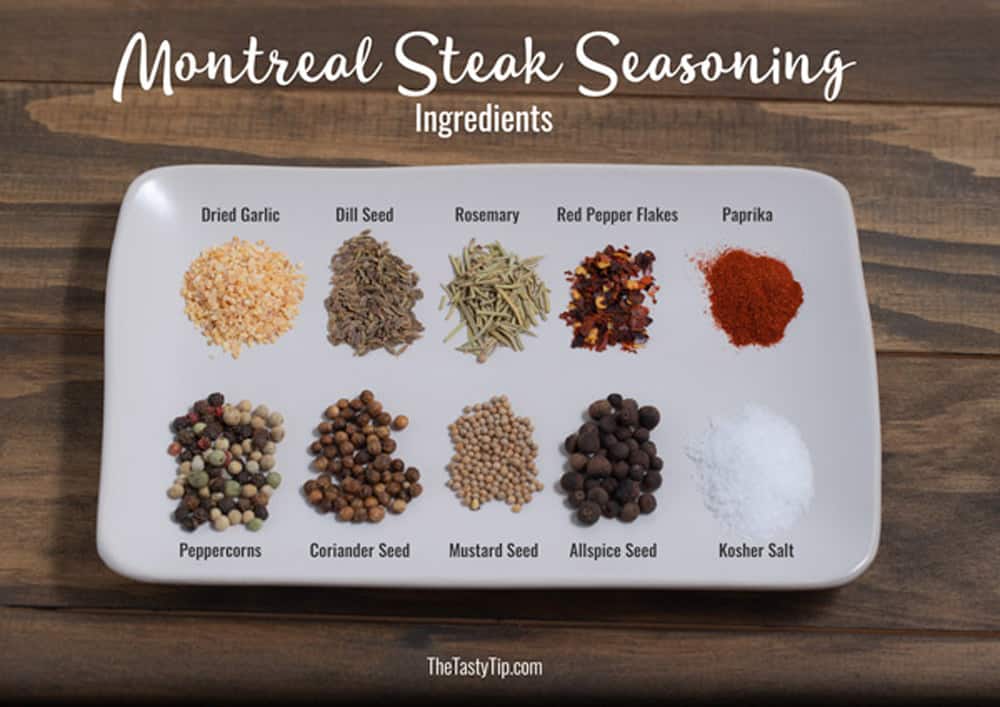
This Montreal steak seasoning recipe combines peppercorns, salt, and basic pickling spices. Use the seed form of coriander, mustard, allspice, and dill.
The secret to a vibrant, fresh recipe is whole spices. I’m a big fan of toasting most spices in this recipe before grinding them.
As soon as a spice is ground, it starts to lose potency. Who knows when commercial coriander was ground before it hit the shelf?
There is a clear difference in taste and aroma between pre-ground and freshly ground spice.
So back to what Montreal steak seasoning is made of … here are the ingredients:
Whole Peppercorns
I recommend a blend of black, white, green, and red peppercorns.
World Market sells them in a packet that is easy to open and grind. You may find other brands in grocery stores.
Beware of the containers with sealed lids. The only way to get the pepper out of these jars is to hand grind it.
If you purchase these peppercorns, you will have to grind them in the jar. This is time-consuming and inefficient. Plus, you can’t toast them before you grind them.
Can you use just black peppercorns? Of course. Black peppercorns are the most widely available peppercorns. However, for a more complex flavor, use a combination of peppercorns. Even a black and white pepper combination is better than using only black peppercorns.
Toast the peppercorns before grinding.
Coriander Seeds
Coriander is the seed of the cilantro plant. These seeds have a light citrus, mildly sweet, earthy flavor when crushed. They are essential in this recipe.
Lightly toast the coriander seeds before grinding.
Yellow Mustard Seeds
Mustard seeds are pungent and slightly bitter. They are often an essential ingredient in pickling spices. This was one of the unexpected spices in the first Canadian steak spice recipe.
Toast them first before grinding them.
Allspice Seeds
Allspice is one spice. But the taste is similar to a combination of nutmeg, cloves, cinnamon, and black pepper. It has a little heat and a strong, warm aroma.
Toast the allspice seeds before grinding them. Your kitchen will smell heavenly.
Dehydrated Garlic
Garlic powder will not be as flavorful as dehydrated garlic. Add a kick with garlic.
Dill Seeds
Dill adds a fresh herbaceous note to a powerful, spicy blend. You can substitute dill weed in place of the seeds if you must.
Sweet Paprika
Paprika adds vibrancy and color to the seasoning mix. This is the only pre-ground spice I use in this recipe. I use powdered paprika because it is labor-intensive to process peppers into paprika.
I have never considered paprika to have much of a flavor. However, it takes some of the bite out of intense peppery flavor. And it balances the taste of all the other spices.
Red Pepper Flakes
Red chili flakes add some heat and color. They add “heat” in a different way than whole peppercorns do. If you like things a little hotter, you can add more than the recipe calls for.
Likewise, omit the red pepper flakes if you like seasoning blends less spicy.
Rosemary
Rosemary brings a little woodsy and peppery flavor to the homemade Montreal seasoning mix. Dried rosemary compliments other flavors without being overpowering.
Coarse Kosher Salt
Salt is a flavorant. This means it brings out the flavors of other ingredients. Yet it doesn’t contribute a taste of its own. It helps release the aroma of food and focuses all the other flavors.
How to Make Montreal Steak Seasoning
- MEASURE out the whole spices and dried herbs.
- TOAST the peppercorns, coriander seeds, mustard seeds, and allspice seeds separately in a small skillet over medium-low heat.
The peppercorns take about 5 to 7 minutes to toast over medium-low heat. Coriander takes about 4 to 5 minutes, mustard seeds takes 3 to 4 minutes, and the allspice seeds take 5 to 6 minutes to toast. Take care to not burn the spices. - COOL the spices for a couple of minutes after toasting them and before grinding them.
- GRIND the spices with a spice grinder, food processor, or blender. If your spice grinder or food processor is small, it may be helpful to grind the spices separately. Pulse 5 to 7 times.
- CRUSH the rosemary, dill seed, and garlic. Pulse 2 to 3 times.
- STIR all the ingredients together in a bowl. Cool to room temperature before storing.
- STORE in an airtight container (like a mason jar). Keep the blend in a cool, dry place (like your spice cupboard) for up to 3 months. Label the sealed jar with the date before placing it in your spice cabinet.
Montreal Steak Seasoning Uses
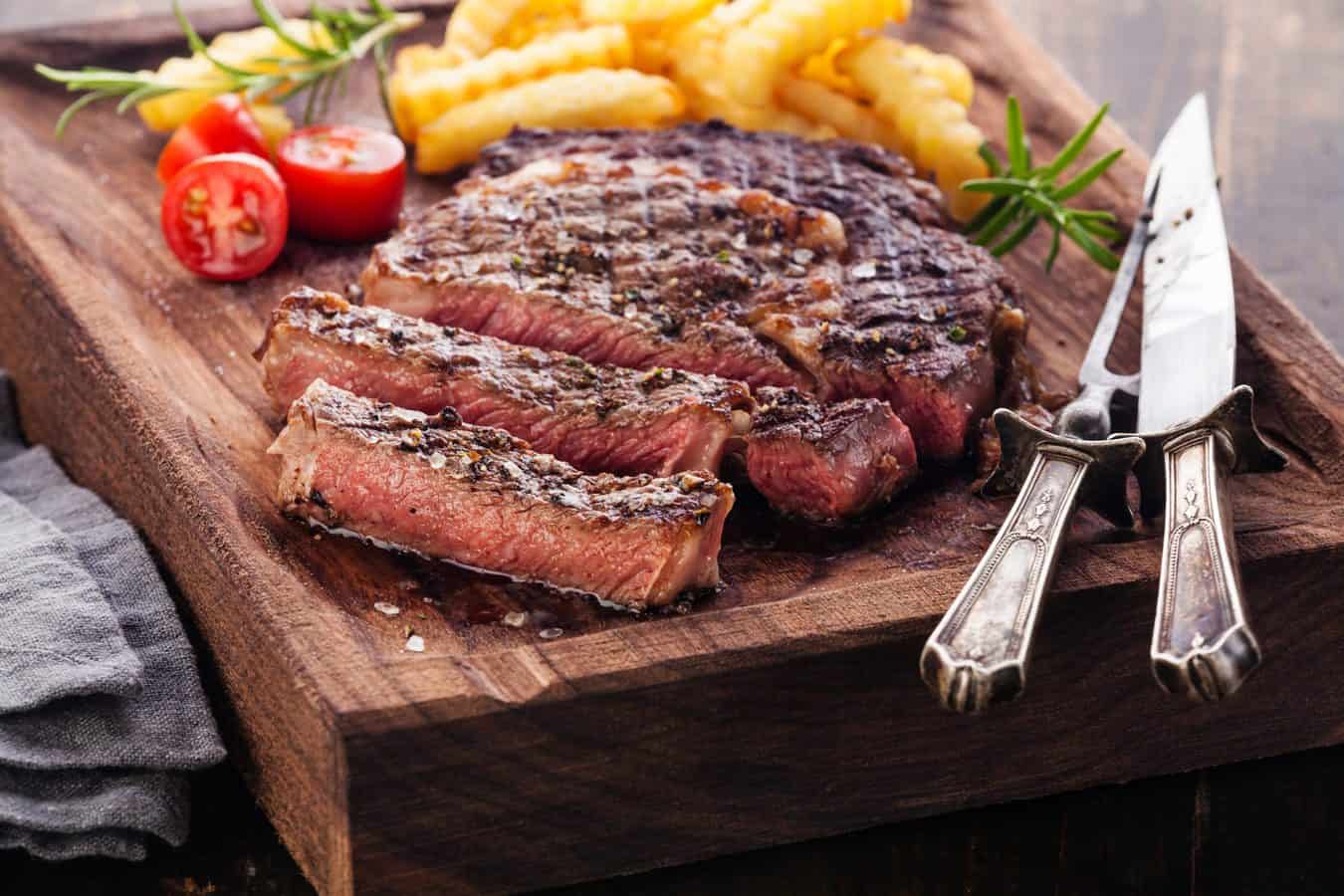
Montreal steak seasoning flavors meat, potatoes, and more. Here are some of my favorite ways to use it.
- Seasoning steak. Make your favorite steaks with this great seasoning. Sprinkle the dry steak seasoning on a steak before throwing it on the grill. When you flip the meat over, sprinkle your homemade spice blend on the other side too.
- Mix it into ground beef to make hamburgers. This grilling season, take your burgers to the next level. Mix homemade Montreal steak spice, brown sugar, and ground beef together. Shape into patties and grill. Delicious.
- Flavor turkey burgers. Add 1½ to 2 tablespoons of Canadian steak seasoning per pound of ground turkey to make turkey burgers.
When the turkey burgers are cooked, garnish with cheddar cheese and sliced apples. The steak seasoning is the perfect balance of savory flavors. And the apple lends the perfect hint of sweetness.
- Add Montreal steak spice to salmon on the grill. It is the perfect night for grilled salmon. A light sprinkling of your homemade seasonings is just the flavoring you need.
- Make easy pork chops. Place the chops in a plastic bag. Add the spice rub and shake to coat. Grill as usual.
- Chicken dry rub. Use it as a dry rub on any grilled or pan-fried chicken with your own blend of steak seasoning on both sides as it cooks. It is the only thing you will need for flavor.
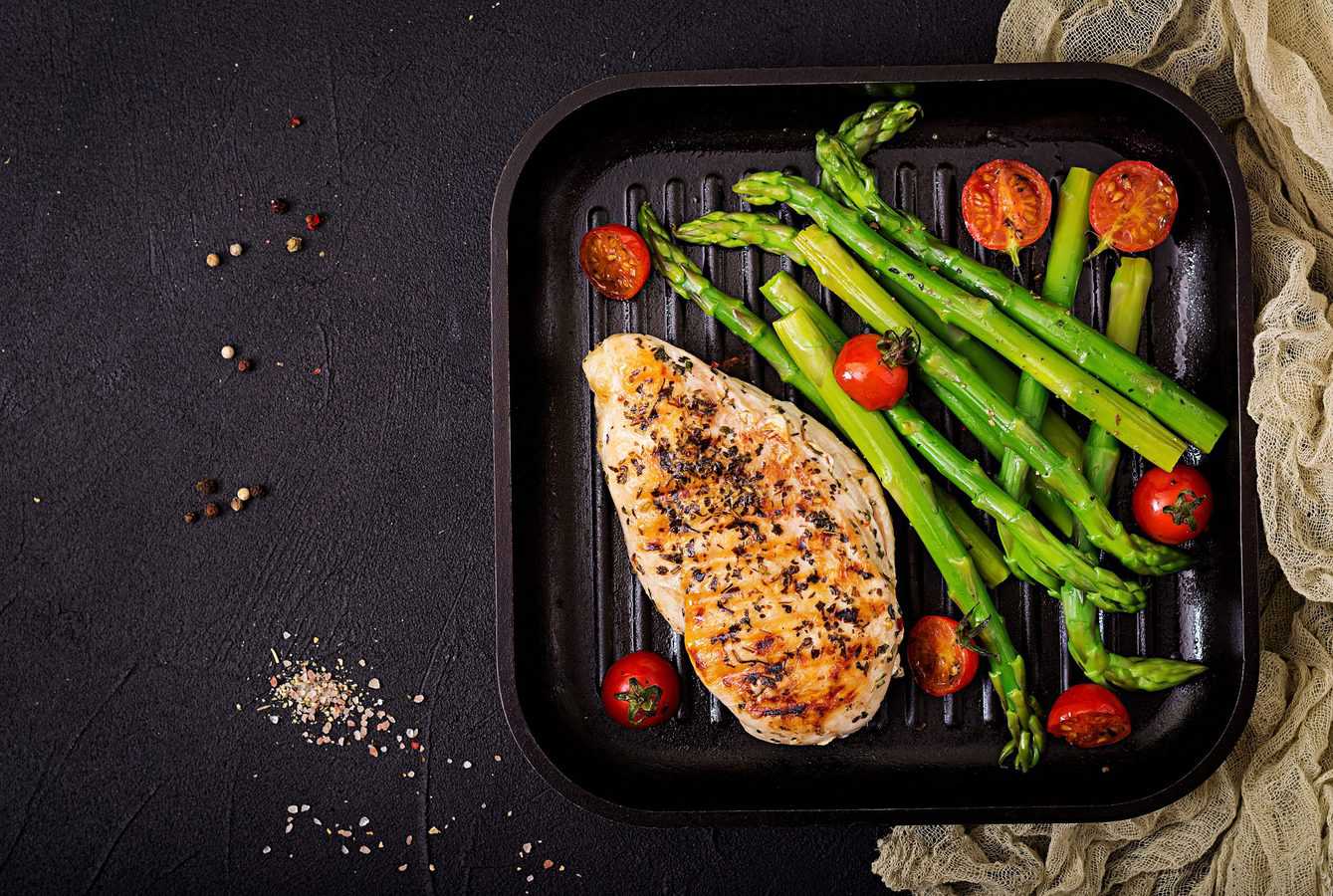
Frequently Asked Questions
Montreal steak seasoning mix was invented at Schwartz’s, Montreal’s oldest deli in Canada. Schwartz’s is famous for smoked meat sandwiches and inventing Montreal steak seasoning.
The best way to flavor any meat is with salt and pepper. Go with simple seasoning if you do not have Montreal steak seasoning and don’t want to make it.
Each manufacturing company has its own recipes for Montreal steak seasoning. If their recipe is gluten-free, it will say so on the label.
If a commercial seasoning mix is not explicitly labeled gluten-free, you cannot assume it is. Don’t guess, even if you do not see wheat, rye, barley, and oats on the ingredient list.
However, if you use this Montreal steak seasoning recipe, you can be sure it is gluten-free. The only ingredients are whole spices, dried herbs, and salt.
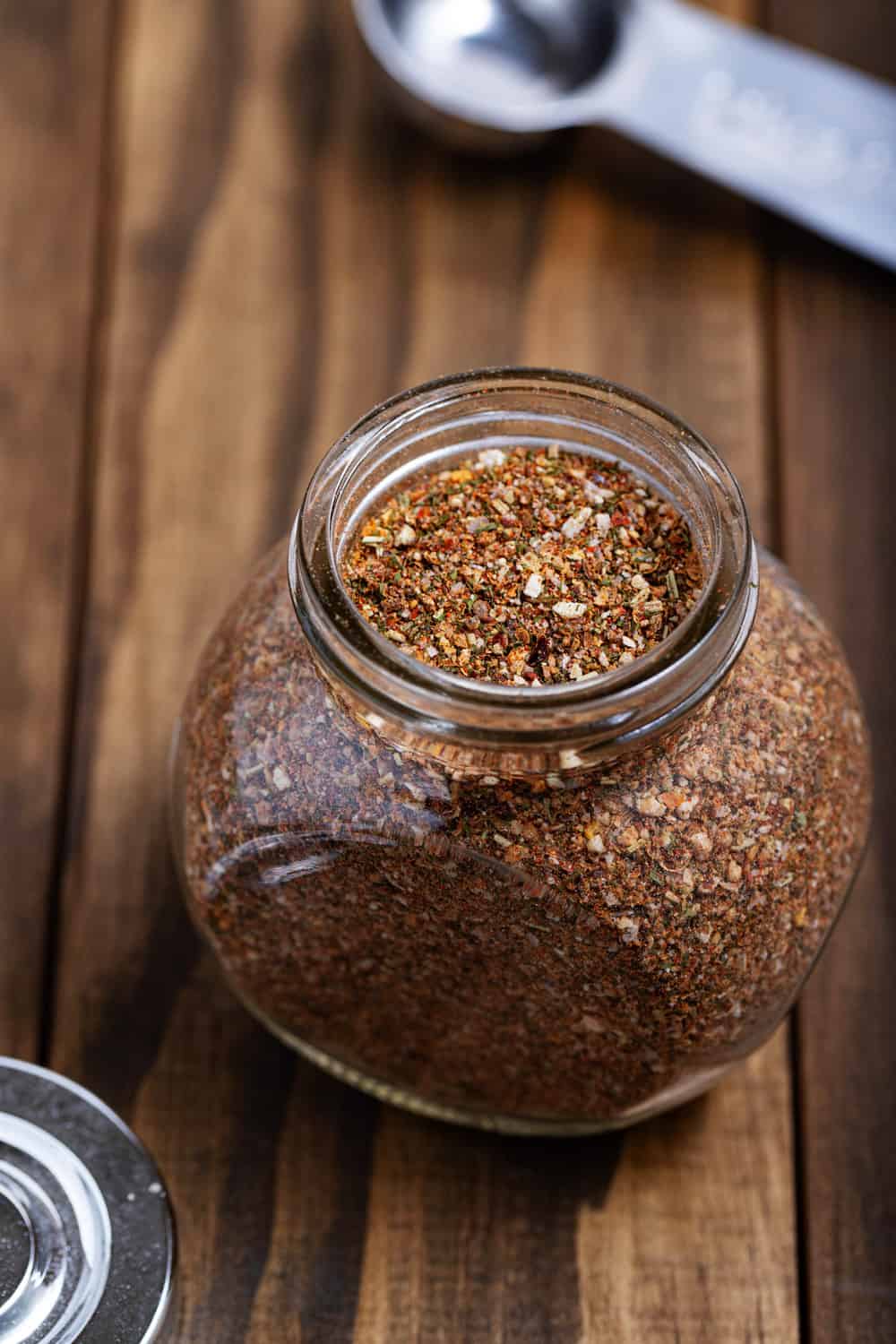
Did you like this post? Then let's be social. FOLLOW ME on PINTEREST and INSTAGRAM to keep up with the latest tutorials, favorite recipes and interesting happenings.
Recipe
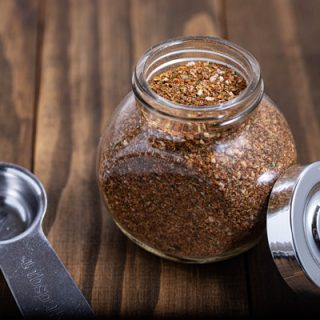
Montreal Steak Seasoning Recipe
Ingredients
- 2 tablespoons mixed peppercorns black, white, green, and red or all black peppercorns
- 2 tablespoons coriander seeds
- 1 tablespoon mustard seeds
- 1 tablespoon allspice seeds
- 1 tablespoon dehydrated garlic
- 1½ tablespoons dill seed dried
- 1 tablespoon rosemary leaves dried
- 2 teaspoons sweet paprika ground
- 1 teaspoon red pepper flakes
- 2 tablespoons Morton kosher salt
Instructions
- MEASURE out the whole spices and dried herbs.
- PRE-HEAT a small skillet on the stove over medium heat.
- TOAST the peppercorns, coriander seeds, mustard seeds, and allspice seeds separately. Because of the different seed sizes, not all the spices toast at the same speed. The peppercorns take about 5 to 7 minutes to toast over medium low heat. Coriander seeds take about 4 to 5 minutes, mustard seeds take 3 to 4 minutes, and allspice seeds take 5 to 6 minutes to toast. Take care to not burn the spices.
- COOL the spices for about 3 minutes before grinding.
- COARSELY GRIND the spices. Use a food processor, spice grinder, or small coffee grinder. Pulse about 5 to 7 times, or until the spices are coarsely ground. If your spice grinder is small, you may need to grind the larger spices separately.
- CRUSH the rosemary, dill, and garlic. I recommend using the same spice grinder or food processor. Pulse 2 to 3 times.
- MIX the ground spices, crushed herbs, and the rest of the ingredients in a medium-sized bowl. Stir with a spoon until all the ingredients are mixed well.
- STORE in an airtight container on your spice shelf for up to 3 months. Spices slowly lose their flavor and aroma after being ground, so keep the lid on the container.
Notes
Nutrition
Did you make this recipe? Tag @thetastytip on Instagram and hashtag it #thetastytip.

Kathy Griffiths
Does Montreal steak spice have MSG in it
Tami Mack @ The Tasty Tip
This recipe does not have MSG in it!! If you are asking about a pre-made spice, you will have to check each manufacturer's label.